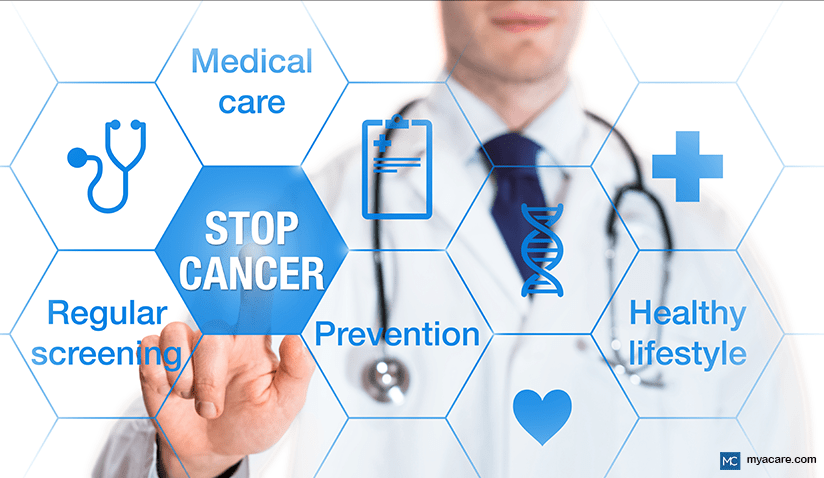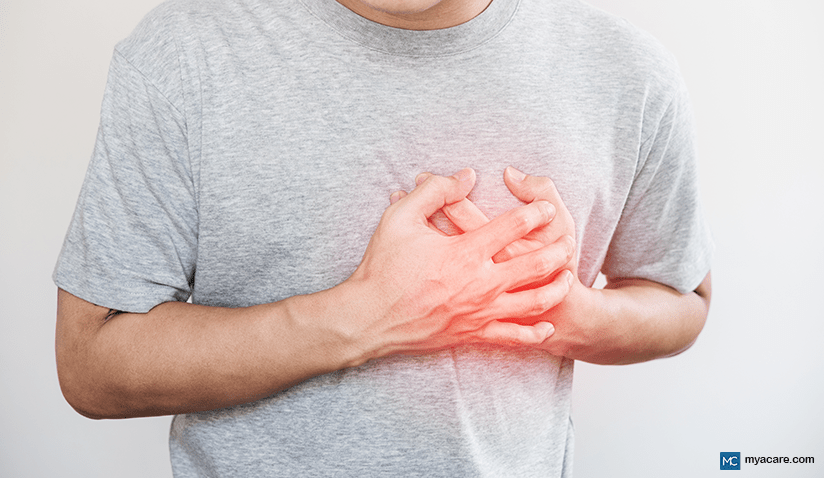CANCER PREVENTION: 8 TIPS TO REDUCE YOUR RISK

Did you know 17 people die every minute due to cancer?
Cancer is one of the leading causes of death worldwide. Estimates suggest cancer kills nearly one million people each year. According to The National Cancer Institute (NCI), the number of new cancer cases per year could rise to 23.6 million by 2030.
Amidst all these gloomy stats, the good news is we can significantly cut down the risk of cancer. As the World Cancer Day approaches, which is on February 4, 2019, let’s look at the evidence-based ways of cancer prevention.
What is Cancer?
Cancer is a group of closely related diseases that cause abnormal growth and multiplication of cells. The abnormal cells (cancer cells) form a mass of tissues (tumor). Depending on the type of cancer, cancer cells can spread to surrounding as well as distant tissues.
There are more than 100 types of cancer. Among these, breast, colorectal, lung, and cervical cancers are the most common in women. In men, the top three cancers are lung, prostate and colorectal cancers.
The treatment options for cancer include:
- Surgery (removal of the tumor and/or surrounding tissues)
- Chemotherapy (use of strong drugs to kill cancer cells)
- Radiotherapy or radiation therapy (use of high doses of radiation, mostly, X-Rays to kill cancer cells)
- Immunotherapy (use of substances that affect the immune system)
Sadly, some forms of cancer can recur even with treatment.
According to the World Health Organization (WHO), cancer is the second leading cause of death globally. Luckily, improvements in cancer screening, early detection, and high-quality treatment have significantly improved survival rates, especially in developed countries.
The updated SEER Cancer Statistics Review suggests that in the US, cancer death rates decreased by:
1.8% per year among men from 2006 to 2015
1.4% per year among women from 2006 to 2015
1.4% per year among children ages 0–19 from 2011 to 2015
The trends show that cancer death rates have declined. Besides, the number of cancer survivors has increased in the last few years.
Nonetheless, cancer remains a major health problem across the world.
What is meant by cancer prevention?
Cancer prevention measures are actions, which we can take to lower the risk of getting cancer. These include healthy lifestyle changes, avoiding cancer-causing substances and taking vaccines and medications, which are known to prevent certain cancers from developing.
However, we should always keep in mind that the following cancer prevention tips do not eliminate the risk. Rather, they reduce the risk. Because cancer develops due to a multitude of genetic and environmental factors, it is not possible to completely prevent cancer.
What are the identified risk factors for developing cancer?
- Genetics and family history
If you have inherited a faulty gene that predisposes you to a type of cancer, you may have a higher chance of developing cancer than others. However, just because you inherited the mutation, that doesn’t mean that you will get cancer.
- Age
Although cancer can affect people of any age, the risk increases with age up to 70 years. The link between increasing age and increased cancer risk is still not clear. Interestingly, one NIH study suggests that cumulative effects of age-associated changes in the genes may be responsible.
- Certain medical conditions
Ulcerative colitis may make you more prone to developing colorectal cancers. Likewise, studies have also shown that people with hepatitis B and C have a higher risk of liver cancer.
How do you reduce the risk of developing cancer?
First things first, you cannot completely prevent cancer. This is because some risk factors, such as genetics are beyond your control.
Nonetheless, you can significantly cut down the risk by adopting healthy lifestyle habits. In fact, the WHO states, “Between 30–50% of cancers can currently be prevented by avoiding risk factors and implementing existing evidence-based prevention strategies”.
Moreover, adhering to cancer prevention guidelines can reduce cancer occurrence and associated death.
Top Eight Cancer Prevention Tips Backed by Science
1. Quit smoking
The link between smoking and cancer is very clear. The Centers for Disease Control and Prevention (CDC) says smoking cigarettes causes nearly 9 out 10 lung cancers.
While smoking is normally associated with causing lung cancer, according to Cancer Research UK, It causes at least 15 different types of cancer including liver, stomach and kidney cancer.
If quitting seems daunting, talk to your doctor on ways to help you quit. There are prescribed medications and nicotine patches, which can help to abstain from smoking. If you are living with people who smoke, ask them to smoke outdoors if needed and never in closed compartments.
Avoid passive exposure as much as possible.
2. Eat a balanced diet
Eat a diet rich in vegetables, fruits, green leaves, whole grains, beans, and lean meats. Study shows that a Mediterranean diet with plant-based foods such as vegetables, fruits, and whole grains reduces the risk of several cancer types.
For protein sources, consider eating more fish. Increased fish consumption could lower the risk of cancer.
Highly processed foods have been linked to cancers of the breast, prostate, and bowel. Thus, limit packaged baked goods, sweetened drinks, sugary cereals, ready meals and reconstituted meat products.
3. Maintain a healthy weight
A growing body of evidence shows that being overweight/obese could increase the risk of several cancer types. For example, cancers of the endometrium, food pipe, stomach, liver, kidney, pancreas, and large intestine.
You can achieve and maintain a healthy weight through a proper diet and regular exercise. You may also visit a dietician and follow a healthy meal plan.
4. Regular exercise
Several studies have shown that increasing physical activity could reduce the risk of many cancer types. These include cancers of the large intestine, breast, and endometrium.
The US Department of Health and Human Services (HHS) recommends at least 150 minutes a week of moderate-intensity aerobic physical activity for adults. Consider brisk walking, jogging, cycling, or any activity that increases your heartbeat.
5. Avoid excessive sun exposure
There is a well-established link between excessive sun exposure and skin cancer. For this reason, limit your exposure to sunlight.
If you have to go outside in the sun, wear protective clothing, use umbrellas, hats, and sunglasses. Apply a good sunscreen of SPF 30 -50 depending on your skin type.
6. Drink alcohol in moderation
The National Toxicology Program of the HHS lists alcohol as a known cancer-causing substance (carcinogen).
Several studies have linked alcohol consumption with different cancer types. These include cancers of the head and neck, food pipe, liver, breast, and colon.
7. Cancer screening
Taking part in cancer screening can help catch cancer before you have the symptoms. The US Preventive Services Task Force recommends screening for breast, cervical, colon, and lung cancers.
8. Immunization
Vaccines for certain viral diseases can reduce the risk of some cancer types. Make sure to receive vaccines for
- Hepatitis B and C – to reduce the risk of liver cancer.
- HPV (Human Papilloma Virus) – to reduce the risk of cervical cancer in women
To Search for some of the best cancer hospitals in Malaysia, India, Thailand, London, and Singapore, please use the Mya Care search engine.
Sources:
- National Cancer Institute. Cancer Statistics.
- World Health Organization. Cancer.
- National Cancer Institute. What is Cancer?
- American Institute for Cancer Research. Worldwide Cancer Data.
- World Health Organization. Cancer Fact Sheets.
- SEER Cancer Statistics Review (CSR) 1975-2015
- Harvard Women’s Health Watch. Medicines to prevent breast cancer.
- Age and Cancer Risk
- NIH study offers insight into why cancer incidence increases with age
- World Health Organization. Hepatitis B Fact Sheets.
- Association Between Hepatitis C and Hepatocellular Carcinoma
- Adherence to cancer prevention guidelines and cancer incidence, cancer mortality, and total mortality: a prospective cohort study
- https://www.cdc.gov/tobacco/campaign/tips/diseases/cancer.html
- Fish consumption and risk of gastrointestinal cancers: A meta-analysis of cohort studies
- Study suggests possible link between highly processed foods and cancer
- National Cancer Institute. Obesity and Cancer.
- National Cancer Institute. Physical Activity and Cancer.
- HHS. Physical Activity Guidelines for Americans.
- Sunscreens in melanoma and skin cancer prevention
- Alcoholic Beverage Consumption
- National Cancer Institute. Alcohol and Cancer Risk.
- Cancer Prevention and Control. Screening Tests.
- National Cancer Institute. Human Papillomavirus (HPV) Vaccines
Disclaimer: Please note that Mya Care does not provide medical advice, diagnosis, or treatment. The information provided is not intended to replace the care or advice of a qualified health care professional. The views expressed are personal views of the author and do not necessarily reflect the opinion of Mya Care. Always consult your doctor for all diagnoses, treatments, and cures for any diseases or conditions, as well as before changing your health care regimen. Do not reproduce, copy, reformat, publish, distribute, upload, post, transmit, transfer in any manner or sell any of the materials in this blog without prior written permission from myacare.com.



